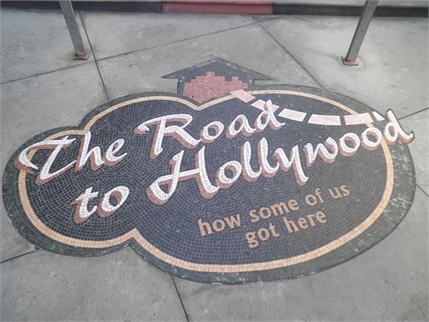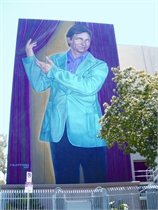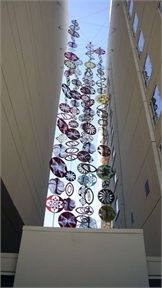Public Art – Playing a role in neighborhood revitalization
public art /puhb-lik ahrt/ (noun): a process involving a community seeking to distinguish itself by art projects that define its identity. Usually such projects involve considerable interaction and buy-in by a number of individuals and organizations that guide it to fruition.
It could be said that if the Hollywood Sign or the Walk of Fame were proposed today, they would be as public art projects.

Erika Rotheberg’s mosaic installation at Hollywood & Highland’s Babylon Court
Although these two iconic projects succeeded in their promotional efforts beyond anyone’s wildest imagination, in recent years many other projects have been added to our public art inventory.
In the mid-80’s, four murals attracted attention and as countless visitors photographed them. Tom Suriya’s “You Are The Star,” Eloy Torrez “Legends of Hollywood,” Richard Wyatt’s “L.A. Jazz” and Alfredo de Batuc’s “Dolores Del Rio” thus received international attention. Suriya’s work was restored in 2008, Torrez’ fell in the 1994 earthquake, the only public art lost and plans for Wyatt’s mural include a redo that will withstand the ravages of time and elements. Years later, George Sportelli’s portraits of Frank Sinatra and Johnny Cash and Hector Ponce painted two murals of Hollywood icons have been added. (See Murals listing in Places of Interest for locations.)

Eloy Torrez painted this addition to his “Portraits of Hollywood” mural on Hollywood High’s auditorium at the request of Jimmy Kimmel, a close friend of John Ritter.
In 1993, the Community Redevelopment Agency of the City of Los Angeles (CRA/LA) created an Arts Advisory Panel to make recommendations for arts and cultural projects financed through its 1% Art Policy fee. The first was the Hollywood Gateway, a picturesque, stainless steel gazebo with figures of legendary actresses Mae West, Dorothy Dandridge, Anna May Wong, and Dolores Del Rio.
When MTA opened its Hollywood stations each had an artist on its design team: May Sun at Hollywood & Western, Gilbert “Magu” Lujan for Hollywood & Vine and Sheila Klein for the futuristic Hollywood & Highland. Each artist gave their station its distinctive character.
When the Hollywood & Highland complex was completed in 2001, CRA/LA’s Art Policy required three major artworks to be showcased on site: a dramatic cascading piece in the escalator space, a Busby Berkley inspired etched granite floor at the entrance to the Kodak Theatre and the poignant Road to Hollywood with actual stories inlaid onto its Babylon Court.

Michael Davis’ 100′ tall hanging sculpture, a gigantic chandelier hangs above the escalator at Hollywood & Highland.
Meanwhile some sections of the Boulevard were slow to revitalize, and in 2003 the Hollywood Arts Council and Hollywood Beautification Team created the Hollywood Night Gallery, portraits of stars whose Walk of Fame stars adjacent to the storefront location which were painted on rolldown security doors installed following the civil unrest in 1992. With funding assistance from the CRA/LA and Hollywood Historic Trust, the project created a welcoming presence for strolling along the Boulevard at night.
Most recently, the new W Hotel and Residences at Hollywood and Vine include four projects by Los Angeles artists that pay tribute to Hollywood’s glamour and allure: Christian Moeller’s expansive sculptural wall links the hotel and Hollywood Blvd. Above, Pae White’s monumental mobile consists of festive forms suspended between the buildings. Erwin Redl’s vast canopy of white LED lights soars overhead at the Argyle entrance and into the open motor court. On Vine, Jennifer Steinkamp’s series of digital columns depict a flower that reference a specific star from the Walk of Fame such as the rosebuds associated with Orson Wells and his production “Citizen Kane”.

Pae White’s monumental mobile moves and shimmers between buildings at the W hotel.
According to Susan Gray, the CRA’s Cultural Arts Planner, “CRA/LA recognizes that the arts play a significant role in neighborhood revitalization. We are committed to attract and retain talented artists and arts organizations and collaborate on urban design and rehabilitation projects that promote an identity for Hollywood as a popular, local, regional and international cultural destination.”
If asked to identify which art form is most identified with Hollywood, it’s doubtful that any of these projects would be mentioned. Yet, each has become part of our Hollywood streetscape with more to follow in years to come. DH